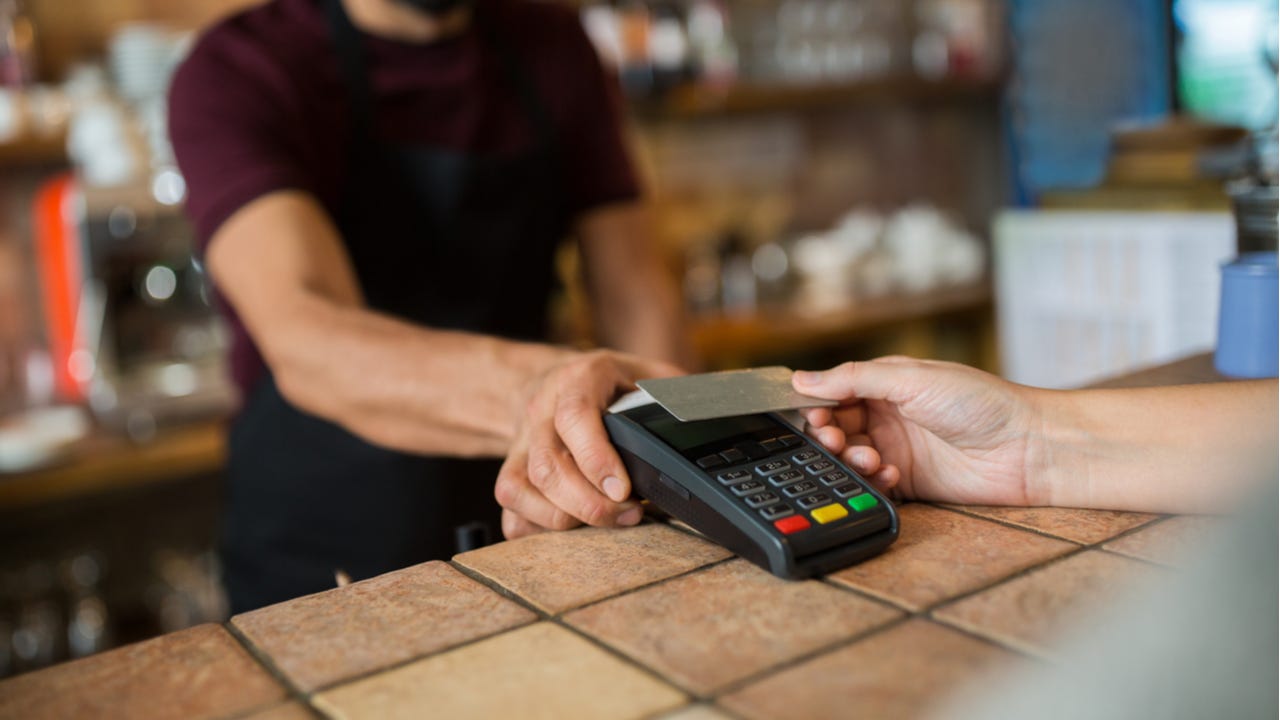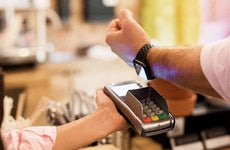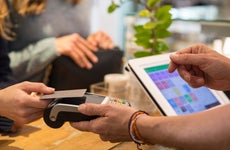What are contactless credit cards?

The Bankrate promise
At Bankrate we strive to help you make smarter financial decisions. While we adhere to strict , this post may contain references to products from our partners. Here's an explanation for . The content on this page is accurate as of the posting date; however, some of the offers mentioned may have expired. Terms apply to the offers listed on this page. Any opinions, analyses, reviews or recommendations expressed in this article are those of the author’s alone, and have not been reviewed, approved or otherwise endorsed by any card issuer.
Contactless credit cards allow you to make credit card payments without having to swipe or insert your card into a credit card terminal. Instead, all you have to do is hover your credit card against the credit card reader. Your transaction should process instantly, often without even requiring a signature.
Contactless payments are on the rise. Visa reported in January that nearly 20 percent of all in-person credit or debit card transactions in the U.S. are now contactless. And it’s likely here to stay, as issuers offer more contactless cards and consumers become comfortable and familiar with the technology.
If you’re making a payment at a credit card terminal that allows contactless transactions or tap-to-pay—and many do these days—all you have to do is hover your card. If you’ve got one of today’s best credit cards, you’ll earn the same rewards with a contactless payment as you would by swiping your credit card. Many contactless transactions complete in just a few seconds, giving you more time to complete your shopping and get on with your day.
Let’s take a look at what exactly a contactless credit card is, how it works and whether or not it is a safe method of payment.
What is a contactless credit card?
Each contactless card contains both a chip and the ability to use radio-frequency identification (RFID) and near-field communication (NFC) to communicate with credit card readers. Contactless chip cards can be inserted directly into a credit card terminal, or you can hover the card near the terminal to activate the chip and make your payment over secure radio frequencies.
Contactless credit cards are exactly the same as tap-to-pay, although no tapping is necessary in the case of contactless credit cards. If you see a credit card (or credit card terminal) described as “Tap to Pay,” it is referring to contactless credit card technology.
Contactless credit cards and tap-to-pay cards also use the same symbol: a series of four curved expanding lines. Look for that icon, which looks a bit like a sideways WiFi icon, on your credit card. That way, you’ll know whether your credit card has contactless capabilities.
How to use a contactless credit card
Contactless credit cards are only compatible with point-of-sale systems that have a contactless-enabled terminal. Coming across a payment terminal that allows you to use your contactless credit card is more common today than it was five years ago, but keep an eye out for the WiFi icon on the payment terminal’s screen to make sure the merchant accepts contactless credit cards.
Once you come across a merchant that accepts contactless pay, you simply hover your card over the card terminal to begin your payment. You don’t have to physically touch your contactless card to the terminal. Much like your standard transaction, after a few seconds the terminal will prompt you with a completion message of sorts and you can put your card back in your wallet. It is that easy!
If you have your credit card loaded on a digital wallet such as Apple Pay or Google Pay, you can also go this route by making a payment with your phone. Simply select which card you want to use from your digital wallet and hold your device over the terminal to complete your transaction.
What are the benefits of a contactless credit card?
Contactless credit cards give you the opportunity to make quick, easy and secure payments by tapping your card against a credit card terminal. Many contactless credit card transactions can be completed without having to let go of your credit card or touch the card terminal with your hands—instead, all you have to do is tap your card against the card reader. Plus, tap-to-pay transactions often go more quickly than transactions where you swipe, dip or insert your credit card into a card reader.
Additionally, contactless payments significantly reduce contact with the public spaces you would normally touch with your credit card when you insert or swipe your card. And the wear-and-tear on your card that comes with repeated contact from payment terminals diminishes with every contactless payment. Your contactless credit card should last you years.
Unfortunately, not all card readers offer contactless technology yet. Even when a card terminal does offer contactless payment, the transaction might not always go through and you might have to swipe or insert your credit card the traditional way. Likewise, if you are hoping to use contactless payment to avoid touching a card terminal completely, be aware that some retailers and card issuers still might require you to use the credit card terminal to sign for your purchase.
That said, more credit card terminals are allowing consumers to make contactless payments, fewer contactless transactions require signatures and the tap-to-pay process continues to run more smoothly.
Are contactless credit cards safe?
Contactless credit cards are just as safe as any other type of credit card. Thanks to the unique way in which the card communicates with the credit card terminal, contactless transactions might even be more secure than standard transactions.
Contactless credit card security not only uses tokenization to transform your credit card number into a random series of alphanumeric characters, but also creates a one-time cryptographic code that links your card to the transaction. These two measures make it very difficult to hack or steal information from a contactless credit card.
Some people wonder if they could accidentally make payments with their contactless credit card—if you’re behind someone in the checkout lane, for example, could your contactless card suddenly activate and pay for the other person’s groceries? Since contactless credit cards can only communicate with card readers from a distance of two or three inches away, you don’t have to worry about accidentally making any payments.
Other people wonder if they need to invest in RFID protection, such as a wallet designed to block RFID frequencies. Not to worry. RFID credit cards already have multiple layers of security built in. And while you can buy an RFID-blocking purse or wallet if you want one, you’re better off using other methods of preventing credit card fraud, such as reviewing your credit card statements and signing up for mobile fraud alerts.
The bottom line
You may already have a contactless chip card in your wallet—a lot of us do, thanks to recent contactless card rollouts. More and more consumers are choosing to make contactless payments, and the combination of speed, ease of use and contactless credit card security has turned tap-to-pay into an extremely popular payment option.
Related Articles



